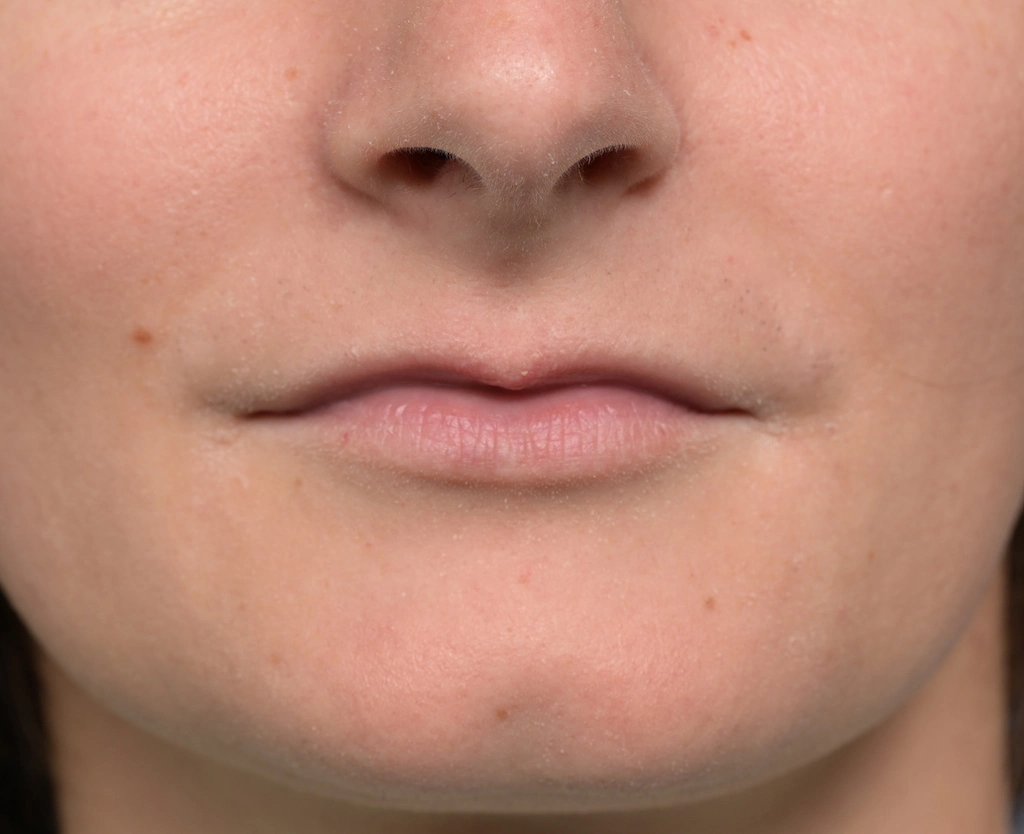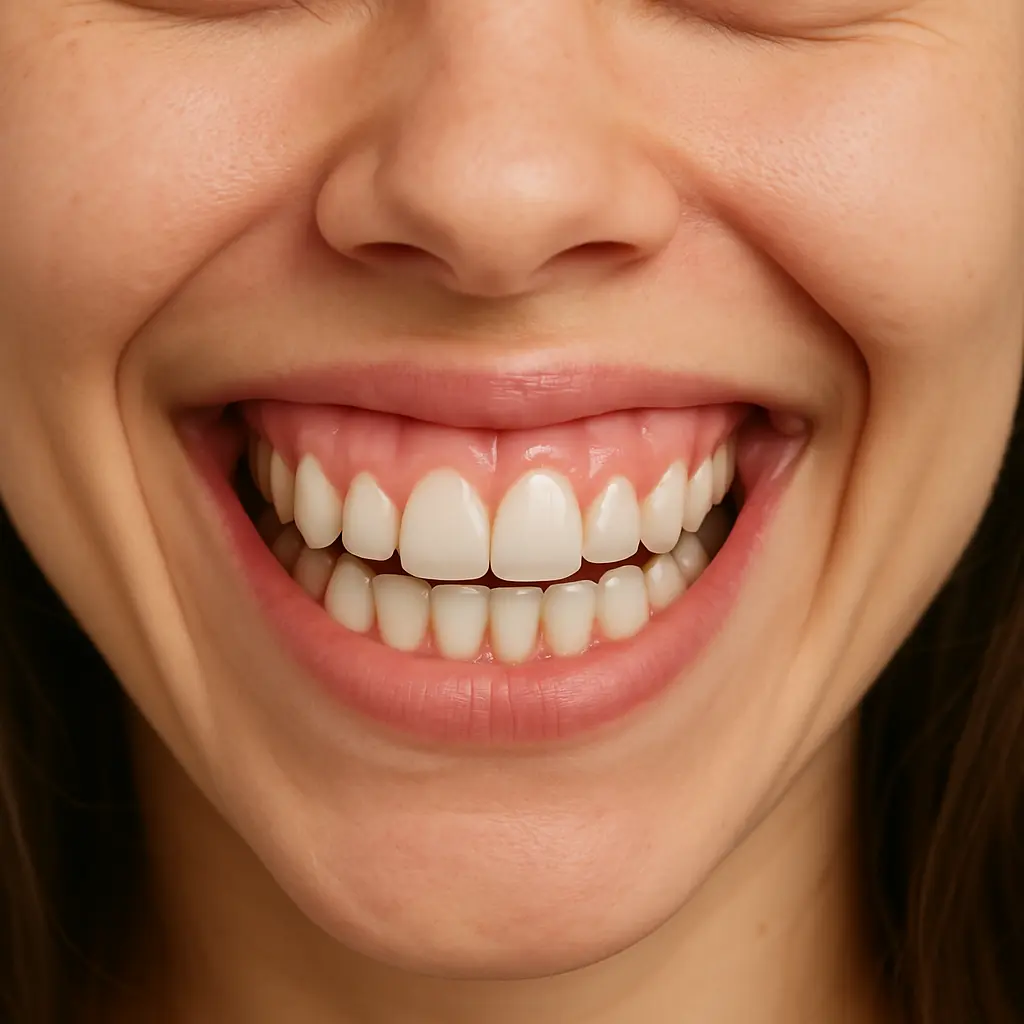Understanding What Gummy Smile is
When you look at your photos, do you notice that your gums are particularly prominent when you smile?
This condition, known as a “gummy smile” or “excessive gingival display” in medical terms, can make some people feel self-conscious about their appearance. But what exactly constitutes a gummy smile, and why does it matter to so many people?
Studies show that gummy smiles become noticeable when 3mm or more of gums show when smiling. Worldwide, what’s considered aesthetically pleasing is a smile that shows minimal gums, allowing your teeth to take prominence.
In fact, a 2006 study by Vincent O. Kokich found that most people rated a smile showing 3mm or more of gum tissue as less attractive.
If you’re concerned about your gummy smile, you’re certainly not alone.
This condition affects between 10.5% to 29% of the population and is more common in females. The good news is that there are numerous treatment options for gummy smile in Singapore available today, ranging from non-surgical approaches to more permanent surgical solutions.
What Causes a Gummy Smile?
Before exploring treatment options, it’s important to understand what causes a gummy smile.
The treatment approach will largely depend on the underlying cause, as there’s no one-size-fits-all solution. Here are the main factors that can contribute to excessive gum display:
1. Under-Eruption of Teeth
Sometimes, when your adult teeth emerge from your gums, they don’t fully erupt to their proper position. These “under-erupted” teeth appear shorter in comparison to the visible gums, creating a gummy appearance.
The teeth remain partially covered by gum tissue, making the gums more prominent when you smile.
2. Teeth Wear and Attrition
If your smile has become more “gummy” over the years, it might be due to tooth wear. This commonly happens due to:
- Teeth grinding (nocturnal bruxism): High-stress lifestyles can contribute to grinding your teeth at night. Over time, this gradually reduces the height of your teeth, making them appear shorter while the gum line remains the same.
- Acid erosion: Frequent consumption of acidic foods and drinks (such as sodas, sports drinks, and citrus fruits) can erode tooth enamel. As teeth get shorter, the jaw bone and gums may shift downward to compensate, making gums more prominent.
3. Hyperactive Upper Lip Muscles
Some people have overactive muscles that control the upper lip (including the levator labii superioris and levator anguli oris). When these muscles are too strong, they cause the lip to rise higher than normal when smiling, revealing more of the gums. This can happen even when teeth and jaw development are perfectly normal.
4. Short Upper Lip

The upper lip plays an important role in masking your gums. If you have a naturally short upper lip, it may not provide adequate coverage of your gums when you smile, resulting in more exposed gum tissue.
5. Excessive Upper Jaw Growth
In some cases, a gummy smile results from a developmental issue where the upper jaw (maxilla) has grown excessively. This excessive growth positions the entire upper jaw and gum line lower, creating a gummy appearance when smiling.
6. Altered Eruption of Teeth During Childhood
The way teeth erupt during childhood development can affect gum appearance. If eruption follows an abnormal pattern, it can lead to an uneven gum line or excessive gum display.
7. Gum Tissue Overgrowth
Certain medications (like Phenytoin, used to treat seizures) or medical conditions can cause excessive gum tissue to form, a condition known as gum hyperplasia. This excess tissue creates a gummy appearance even when teeth and jaw development are normal.
Non-Surgical Treatment Options for Gummy Smiles
If you’re looking to address your gummy smile without undergoing major surgery, several effective options are available:
1. Botox Treatment for Gummy Smile
Botulinum toxin (Botox) injections have become one of the most popular treatments for gummy smiles caused by hyperactive upper lip muscles.
How it works: Small amounts of Botox are injected into the muscles that control the upper lip movement. This temporarily relaxes these muscles, limiting how high the lip rises when you smile.
Procedure details:
- Quick, relatively painless procedure
- Usually takes just 5-10 minutes
- Requires only a few small injections
Results:
- Effects typically appear within a few days to two weeks
- Reduces gum exposure while maintaining a natural-looking smile
- Results last approximately 3-6 months, requiring periodic touch-ups
Benefits:
- Minimally invasive with no downtime
- Reversible (if you don’t like the results, they’ll wear off)
- Can be used as a “trial run” before considering more permanent solutions
Considerations:
- Not a permanent solution, requiring repeat treatments
- In some regions, only qualified medical professionals can administer Botox
- Must be carefully dosed to avoid over-correction, which could affect your smile or speech
2. Dermal Fillers for Gummy Smile

Dermal fillers offer another non-surgical approach, particularly helpful for those with a short upper lip.
How it works: Fillers are injected into the upper lip to add volume, which helps the lip cover more of the gum line when smiling.
Procedure details:
- Takes approximately 10-15 minutes
- Minimal discomfort with topical anesthetic
- Immediate results
Results:
- Plumper lips that provide better coverage of gums
- Additional aesthetic benefits for lip appearance
- Effects typically last 6-12 months
Benefits:
- Dual benefit of addressing gummy smile while enhancing lip appearance
- No downtime required
- Gradual return to pre-treatment state if discontinued
Considerations:
- Temporary swelling may occur during the first 24-48 hours
- Results are temporary, requiring maintenance treatments
- May not be sufficient for severe cases
3. Natural Approaches and Facial Exercises
For those interested in completely non-invasive approaches, certain facial exercises might help reduce the appearance of a gummy smile, especially for mild cases involving lip mobility issues.
Exercise regimen:
- Nose-to-mouth massage: Use your index finger to massage the area from the wings of your nose to the corners of your mouth for 30 seconds daily. This helps relax overactive upper lip muscles.
- Lip hold exercise: Open your mouth, then close and hold your lips together for 10 seconds. This strengthens lip muscles and helps them better cover the gums.
- Controlled smile practice: Practice smiling while slightly closing your mouth to cover more of your gums. Hold this position for one minute daily.
- Cheek muscle exercise: Make a “fish face” by sucking in your cheeks and holding for 30 seconds. This helps strengthen the muscles around your cheeks and can improve smile control.
Benefits:
- Completely free and non-invasive
- No side effects
- Can complement other treatments
Considerations:
- Results vary significantly between individuals
- Requires consistent practice to see any improvement
- May not be effective for more severe cases or those caused by skeletal issues
4. Scaling and Polishing
Sometimes, gum inflammation due to poor oral hygiene can contribute to a gummy appearance. Professional dental cleaning can help reduce this inflammation.
How it works: Professional dental cleaning removes plaque and tartar buildup, reducing gum inflammation and potentially reducing the appearance of excessive gum tissue.
Benefits:
- Improves overall oral health
- May reduce gum swelling that contributes to gummy appearance
- Non-invasive approach
Considerations:
- Only effective if inflammation is a contributing factor
- Not a solution for structural causes of gummy smile
- Requires maintaining good oral hygiene practices
Dental Procedures for Treating Gummy Smiles
For more definitive results, especially for cases involving tooth or gum structure issues, various dental procedures can provide excellent outcomes:
1. Laser or Scalpel Gum Gingivectomy
This procedure is ideal for cases where excessive gum tissue is the primary cause of the gummy smile.
How it works: A dental professional uses a laser or scalpel to remove and reshape excess gum tissue, exposing more of the tooth structure and creating a more balanced smile.
Procedure details:
- Usually performed under local anesthesia
- Takes about 30-60 minutes depending on the number of teeth treated
- Minimal discomfort during and after the procedure
Results:
- Immediate improvement in gum-to-tooth ratio
- More tooth surface becomes visible
- Creates a more aesthetically pleasing smile line
Benefits:
- Relatively comfortable procedure with quick healing
- Provides immediate results
- Laser approach offers precision and minimal bleeding
Considerations:
- If there is excessive bone underneath the gums, the gums may regrow to their original position
- May need to be repeated if not combined with bone reshaping when necessary
- Healing process requires special care for 1-2 weeks
2. Crown Lengthening with Osseous Surgery
For cases where both excessive gum tissue and underlying bone structure contribute to the gummy smile, a more comprehensive approach is needed.
How it works: This two-part procedure involves removing excess gum tissue (gingivectomy) and reshaping the underlying bone (osseous surgery) to create a permanent change in the gum line.
Procedure details:
- Performed under local anesthesia
- More involved than gingivectomy alone
- Typically requires 1-2 hours depending on extent
Results:
- Permanent reduction in gum display
- Better proportion between teeth and gums
- Long-lasting results without the need for repeat procedures
Benefits:
- Addresses both gum and bone issues for complete correction
- Creates stable, permanent results
- Can dramatically improve smile aesthetics
Considerations:
- More invasive than gingivectomy alone
- Requires longer healing period (2-3 weeks)
- Higher cost than simpler procedures
3. Porcelain Veneers or Crowns
When the gummy smile is related to short or worn teeth rather than actual excess gum tissue, dental prosthetics offer an excellent solution.
How it works: Thin porcelain shells (veneers) or full crowns are placed over the existing teeth to make them appear longer, creating better proportions with the gum line.
Procedure details:
- Requires minimal tooth preparation for veneers
- More extensive preparation for crowns
- Usually takes 2-3 dental visits to complete
Results:
- Instantly longer-looking teeth
- Improved tooth-to-gum ratio
- Additional cosmetic benefits (whiter, straighter-looking teeth)
Benefits:
- Addresses multiple cosmetic concerns simultaneously
- Can be combined with other procedures for comprehensive smile makeover
- Results last 10-15+ years with proper care
Considerations:
- More expensive than some other options
- Requires some irreversible modification of natural teeth
- Not suitable if the gummy smile is caused primarily by lip or jaw issues
4. Orthodontic Treatment
When misaligned teeth or jaw relationships contribute to a gummy smile, orthodontic intervention may be necessary.
How it works: Braces or clear aligners are used to reposition teeth, sometimes in combination with temporary anchorage devices to intrude (push upward) upper front teeth.
Treatment duration:
- Typically ranges from 12-30 months
- Regular adjustments required
- May be combined with other procedures
Results:
- Improved tooth position and alignment
- Better relationship between teeth and gums
- Overall enhancement of smile aesthetics
Benefits:
- Addresses fundamental structural issues
- Improves both function and appearance
- Results are permanent with proper retention
Considerations:
- Lengthy treatment time
- Can be combined with surgical approaches for severe cases
- May require lifetime retention to maintain results
Surgical Approaches for Gummy Smile Correction
For more severe cases, especially those involving skeletal or significant lip mobility issues, surgical interventions offer the most dramatic and permanent results:
1. Lip Repositioning Surgery
This procedure is particularly effective for gummy smiles caused by hypermobile upper lips that rise too high when smiling.
How it works: The surgeon makes an incision inside the upper lip, removes a small strip of tissue, and repositions the lip to limit its upward movement when smiling.
Procedure details:
- Performed under local anesthesia, sometimes with sedation
- Takes approximately 30-90 minutes
- Involves internal stitches that dissolve over time
Results:
- Permanent reduction in gum exposure when smiling
- Natural-looking smile with limited lip mobility
- Significant improvement in smile aesthetics
Benefits:
- Long-lasting results
- Addresses the specific problem of hypermobile lips
- Minimally invasive compared to jaw surgery
Considerations:
- Minor discomfort and swelling for 7-10 days
- May affect the appearance of the upper lip
- Not suitable for cases caused primarily by skeletal issues
2. Vertical Maxillary Impaction (Orthognathic Surgery)
For severe cases caused by excessive growth of the upper jaw, corrective jaw surgery provides the most comprehensive solution.
How it works: An oral and maxillofacial surgeon repositions the entire upper jaw (maxilla) upward to reduce gum exposure and improve facial proportions.
Procedure details:
- Major surgery performed under general anesthesia
- Typically requires hospital stay
- Often combined with orthodontic treatment
Results:
- Dramatic improvement in facial proportions
- Significant reduction in gum display
- Comprehensive correction of severe gummy smiles
Benefits:
- Addresses fundamental skeletal causes
- Improves both function and aesthetics
- Provides permanent correction
Considerations:
- Most invasive option with longest recovery period (4-6 weeks)
- Higher cost than other treatments
- Reserved for severe cases where other approaches would be insufficient
Choosing the Right Treatment Approach
With so many options available, how do you decide which treatment is right for your gummy smile? The decision should be based on several factors:
1. Accurate Diagnosis
The first and most crucial step is getting an accurate diagnosis of what’s causing your gummy smile. A qualified dental professional can help determine whether your condition stems from:
- Teeth issues (short crowns, wear, eruption problems)
- Gum issues (excessive tissue, inflammation)
- Lip issues (hypermobility, short upper lip)
- Skeletal issues (excessive jaw growth)
Different causes require different treatments, and a misdiagnosis could lead to unsatisfactory results.
2. Severity Assessment
The extent of gum display significantly influences treatment recommendations:
- Mild cases (3-4mm of gum display): Often respond well to non-surgical approaches like Botox or dermal fillers
- Moderate cases (5-7mm of gum display): May require dental procedures like crown lengthening or orthodontics
- Severe cases (8mm+ of gum display): Often need surgical intervention for satisfactory results
3. Personal Preferences
Consider your own priorities regarding:
- Treatment invasiveness: Are you comfortable with surgery, or do you prefer non-invasive options?
- Result permanence: Do you want a permanent solution or are you comfortable with maintenance treatments?
- Recovery time: How much downtime can you accommodate in your schedule?
- Budget considerations: What investment are you willing to make in your smile aesthetics?
4. Combined Approaches
Many patients achieve the best results through a combination of treatments. For example:
- Botox plus gum contouring for cases with both lip and gum issues
- Orthodontics followed by crown lengthening for complex cases
- Veneers after crown lengthening to maximize aesthetic improvements
Cost Considerations for Gummy Smile Treatments
Treatment costs vary widely based on the procedure, geographic location, practitioner expertise, and extent of treatment needed:
- Botox injections: $300-800 per treatment, needed every 3-6 months
- Dermal fillers: $500-1,200 per treatment, needed every 6-12 months
- Gingivectomy/laser gum contouring: $600-3,000 depending on the number of teeth
- Crown lengthening with osseous surgery: $1,500-4,000
- Porcelain veneers: $800-2,500 per tooth
- Orthodontic treatment: $3,000-8,000 for comprehensive treatment
- Lip repositioning surgery: $2,000-5,000
- Orthognathic surgery: $20,000-40,000, possibly partially covered by insurance if functional issues exist
Many dental offices offer financing options to make these treatments more accessible, and some procedures may be partially covered by dental insurance if they address functional concerns beyond aesthetics.
Recovery and Aftercare
Proper aftercare is essential for optimal results and minimal complications:
For Non-Surgical Treatments
- Botox: Avoid rubbing the treated area for 24 hours and refrain from strenuous activity for 24-48 hours
- Fillers: Apply ice to reduce swelling, avoid excessive heat or pressure on the treated area for 24-48 hours
For Dental Procedures
- Gingivectomy/Crown Lengthening:
- Eat soft foods for the first few days
- Use prescribed antimicrobial mouthwash
- Avoid hot, spicy, acidic foods during healing
- Follow specific oral hygiene instructions
- Attend follow-up appointments to monitor healing
For Surgical Procedures
- Lip Repositioning:
- Take prescribed pain medication as directed
- Use ice packs to minimize swelling
- Follow a soft food diet for 7-10 days
- Avoid stretching or manipulating the lip during healing
- Orthognathic Surgery:
- Adhere to liquid/soft food diet as recommended (potentially for several weeks)
- Complete jaw physiotherapy exercises as prescribed
- Attend all follow-up appointments
- Allow adequate time off work/school for recovery (typically 2-3 weeks)
Preventing Gummy Smile Worsening
While many causes of gummy smiles are congenital or developmental, you can prevent certain conditions from worsening:
- Use a night guard if you grind your teeth to prevent further wear
- Limit consumption of acidic foods and beverages to prevent enamel erosion
- Maintain excellent oral hygiene to prevent gum inflammation
- Address medical conditions that might contribute to gum overgrowth
- Consider alternative medications if you’re taking drugs known to cause gum hyperplasia
Final Thoughts: Finding Your Perfect Smile
A beautiful smile is as much about confidence as it is about aesthetics. While studies show certain proportions are generally considered more attractive, the “perfect smile” varies among individuals and cultures.
The decision to treat a gummy smile should be personal and based on your own comfort and confidence. Some people embrace their gummy smile as a unique characteristic, while others prefer to modify it for aesthetic reasons. Neither choice is wrong.
If you’re considering treatment, consult with an experienced dental professional who can:
- Provide an accurate diagnosis of the underlying cause
- Present all suitable treatment options
- Create a customized treatment plan
- Set realistic expectations about outcomes
Remember that modern dentistry offers more solutions than ever before for addressing gummy smiles, from temporary, non-invasive approaches to permanent surgical corrections. With the right information and professional guidance, you can make an informed decision about the best approach for your unique situation.
Whether you choose to embrace your natural smile or pursue treatment, the most important aspect of any smile is the confidence behind it.

